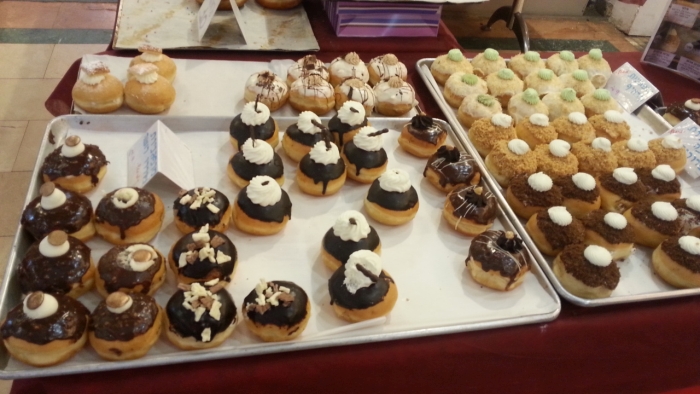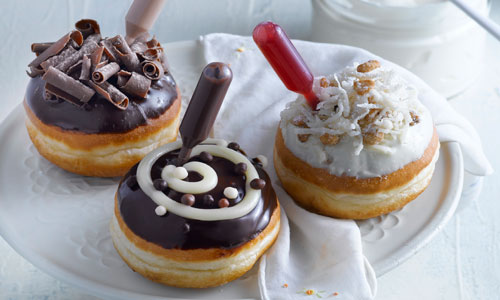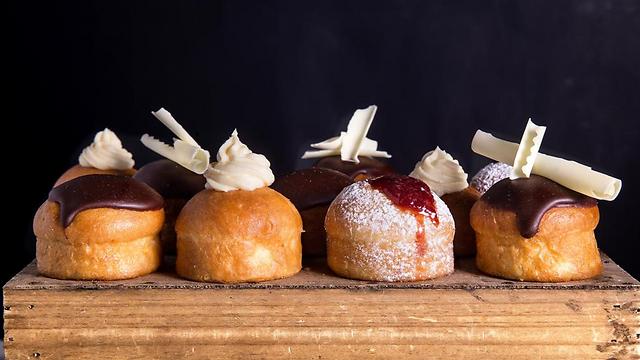(Last updated: December 15, 2017)
Israelis love donuts. We know that because the 8 million
people of Israel consume 24 million donuts a year (Dr. Yvette Alt Miller, “8
Interesting Facts about Donuts”, aish, December 13, 2017). When you walk
the streets of Jerusalem at Chanukah-time, you might easily conclude that most of those 24 million
donuts are probably eaten at Chanukah.
On Chanukah in Israel, the Israeli 'donut' is everywhere. It appears at the shuk, in bakery shops, supermarkets and Malls. It appears in multiple colors, flavors and arrangements.
On Chanukah, a virtual army of donuts lines up to march through Israel:
from: "Israeli Health Minister declares--out!", timesofisrael, December 12, 2016
from: Jacob Richman, machat, jrcoil/hotsites/chanukah-photos, retrieved December 14, 2017
from: Jacob Richman, ibid
from: Jacob Richman , ibid
from: Jacob Richman, ibid
from: Jacob Richman, ibid
from: the 5 best places for sufganiots in Israel, yeahthatskosher, November 9, 2015
from: City Mouse Online, "The 8 best Hanukah sufganiot in Israel", harretz, November 24, 2013
from: haaretz, ibid
from: haaretz, ibid
from: haaretz, ibid
from: haaretz, ibid
from: haaretz, ibid
from: Karen Brown, "The sweet stuff", timeoutisrael, December 3, 2017
Photo by Sarit Geffen , in "Where to get some of the best Chanukah donuts [in Israel]", ynetnews, December 12, 2015.
Photo by: Ronen Mangan, ynetnews, ibid
Yes, the Israeli 'donut' is not a cookie-cutter item. For Israelis, if you can imagine it, you can do it with a donut.
Well, almost.
What's an Israeli 'donut'? Let's start first with a history of the donut. Then, you'll learn about the Israeli 'donut'.
This history lesson comes from Dr. Yvette Alt Miller, “8 Interesting Facts about Donuts”, aish,
December 13, 2017:
Donuts, or sufganiyot in Hebrew, are a quintessential part
of Hanukkah in Israel and much of the Jewish world. Fried in oil, they recall the miracle of oil
that burned for eight days.
Here are eight interesting facts about donuts:
Ancient Origins
Fried dough - the precursors to today’s donuts - was enjoyed
in ancient times throughout Greece and Rome.
Strips of dough were fried, often in olive oil, and then sprinkled or
spread with ingredients to add flavor…
Bringing Donuts to Europe
Fried dough was popular throughout the Middle East during
the Medieval period. These donuts
differed from ancient pastries in that they were made with yeast, much like
modern doughnuts are today. Because too
much sugar kills yeast, these doughnuts weren’t terribly sweet, and it was
popular to drench them in sugar syrup once they were cooked.
These Middle Eastern delicacies gradually spread into Europe,
in part spread by Jewish merchants and cooks.
To this day, many Sephardi Jews prepare “Bimuelos” for Hanukkah:
delicious yeast doughnuts which are first fried and then drenched in a sugar
syrup, which often flavored with lemon, rose water or orange-blossom
water. Some Egyptian Jewish communities
call these sticky types of sweets “zalabia”; in Iraqi Jewish communities they
are sometimes called “zengoula”.
The first recipe for a jam-filled donut was published in
Germany in 1485. At the time, many donuts
were filled with savory fillings such as fish or mushrooms, but it seems that
sweet doughnuts were becoming popular too.
“Gefullte Krapfen” is a recipe for a dollop of jam placed between two
rounds of yeast bread and deep fried in lard.
Making Donuts Kosher
Jewish cooks in Europe made one key change [to the donut]:
instead of frying donuts in lard, they substituted other fats, including
schmaltz and goose fat. In Poland, Jews
called their variation ponchiks, and soon adopted them as a Hanukkah specialty.
Coffee and a Donut
In the 1700s and 1800s, Europeans began eating donuts as an
accompaniment to a new drink that was sweeping Europe: coffee. Jews were highly instrumental in spreading
the taste for coffee throughout Europe.
The first coffee houses in Europe, opened in 1632, in Livorno, Italy,
were opened by Jews. England’s first
coffee house was opened in Oxford in 1650 by a Jewish immigrant from Lebanon
called “Jacob the Jew”.
Jews owned many coffee houses in France, Germany, the
Netherlands, and elsewhere, and in many cases offered pastries - including
doughnuts - to go with the new beverage.
As coffee gained in popularity, so did donuts: the perfect accompaniment
to a hot cup of coffee in the morning or for an afternoon snack.
Donuts for Everyone
Donuts were introduced to the New World by Dutch settlers
and were a popular home-made treat.
During World War I, both the Red Cross and Salvation Army gave American
servicemen donuts as a tasty treat; after the war, thousands of servicemen
returned home with a greater taste for donuts than ever before.
Adolph Levitt was a Jewish refugee from Russian pogroms who
moved to New York and opened a store in Harlem, in which he made donuts. In 1920, he devised an automated donut making
machine, allowing cooks to produce hundreds of high-quality donuts a day. In 1925, Mr. Levitt produced a donuts mix
that bakers could use with his machines, guaranteeing consistent quality.
The demand for donuts exploded. Mass produced doughnuts, made using Mr.
Levitt’s machines, were called “the food hit of the Century of Progress” at the
1934 Chicago World’s Fair…. More and
more, specialist donut making companies produced America’s donuts, and sold the
cakes to restaurants, bakeries and cafeterias.
By the 1950s, Adolf Levitt’s company, the Doughnut Corporation of
America, was selling over $25 million worth of donut making equipment each
year, and donuts were America’s favorite pastry.
Franchising Donuts
In the mid-20th Century, William Rosenberg, a Jewish son of
immigrants who was living in Dorchester, Massachusetts, operated a corporate
catering business. He noticed that
coffee and donuts alone accounted for nearly half of his business, and quit to
focus on donuts and coffee full time. He
opened a donut shop in 1948, and introduced an innovative new gimmick: offering
52 varieties of donuts, enough for customers to sample a new donuts type each
week of the year.
Within a few years, Rosenberg began franchising other donut shops,
and he soon changed the name of his chain from the original name, “Open Kettle”
to something more catchy: “Dunkin’ Donuts”.
By the time Rosenberg died in 2002, Dunkin’ Donuts had over 5,000
outlets, including 40 under kosher supervision, in 40 countries around the
world. Dunkin’ Donuts’ success had also
spawned a number of imitators, ensuring that the craze for doughnuts continued
to grow.
Millions of Donuts
Always popular, donuts have become even more sought after in
recent years. In the United States, it’s
estimated that consumers spend over half a billion dollars on the round
confections annually. In the US,
convenience stores alone sold 391 million donuts in 2014. Canadians might consume the most donuts in
the world: they have more donut shops per capita than any other country. Britain is in the midst of a donuts moment:
the Daily Telegraph called donuts Britain’s new favorite treat in 2017.
Israeli Donuts: Sufganiyot
In Israel, plump, jam or custard-filled sufganiyot, as
donuts are known in Hebrew, are enjoyed each year at Hanukkah. One recent survey found that 80% of Israelis
eat at least one donut during the eight-day festival.
Sufganiyot derive their name from a spongy dough that’s
mentioned in the Talmud: sofgani. These
Israeli confections aren’t doughnut shaped at all: instead of having a hole in
the middle (which helps create a more evenly cooked doughnut), sufganiyot are
baked round, then injected with a filling after cooking. About 70% of sufganiyot are stuffed with jam,
but Israeli bakers experiment with other fillings, such as caramel, espresso
cream, chocolate, halva - even fillings flavored like the popular Israeli
peanut snack Bamba.
Each year Israelis consume about 24 million sufganiyot. The Israeli Defense Force alone buys about
half a million sufganiyot for the troops.
In recent years, sufganiyot have become popular outside of Israel, as a
tasty addition to the Hanukkah holiday table.
--
In our Israel household, we hold a 'Sufganiot Festival' each Chanukah. It's informal. It's unofficial. But it gives us reason to scarf down as many suganiot as we like.
We just love our sufganiot.
When people ask me if I eat sufganiot, I reply that I do eat them, but only if they're made by my wife. When they ask me why, I reply, her recipe comes directly from Gan Eden, the Garden of Eden.
Ahhh, such taste!
Happy Chanukah!



















